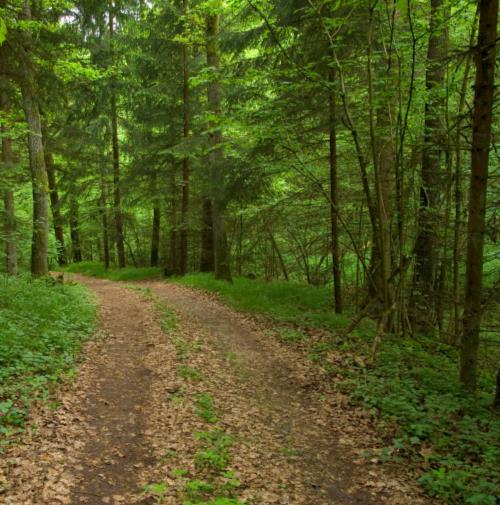Forest Road Management

Description
Forest roads, also called truck roads, are roads that provide access for forest management and recreational activities. Although forest roads are necessary, they pose numerous adverse effects on the forest including: hydrology and geomorphic effects (debris slides and sedimentation), habitat fragmentation, degraded water quality, chemical contamination, degraded aquatic habitat, decline in biodiversity, and depressed local economies. By utilizing several preventive and maintenance best management practices, the forest ecosystem can be preserved (USDA, 2000).
Applicability
Best management practices can apply to both proposed roads and existing roads. When constructing roads, location and design should be carefully considered as good location can greatly reduce sediment transport to surrounding water bodies. Forest roads should also follow the contour of the land and be far removed from steep gradients and poor drainage areas to minimize erosion and sediment load. In addition, care should be taken to minimize road length, width, and interception with water (USEPA, 1997). Plant removal should be kept to a minimum as this can cause leeching of nutrients, increased sedimentation, interruption of the nitrogen cycle, and increased temperatures in water bodies. Erosion and sedimentation are the two main NPS pollutants encountered with forest roads and special design consideration (such as ditches and culverts) should be utilized when designing and maintaining roads (USEPA, 1999).
Cost
Forest roads are extremely expensive to construct and to maintain (Hohmann, 2001). From 1985 through 1996 the National Forest Service appropriated $1,938,079,000 for road construction/reconstruction and $943,918,000 for road maintenance (WCPR, 2002). Current funding is inadequate to maintain all of the existing roads to intended safety, service, and environmental standards to permit efficient and safe use, while mitigating adverse environ mental impacts (USDA, 2002). The most economical best management practice is to decommission all unnecessary roads and to utilize the least expensive BMP techniques when designing new roads and upgrading all active roads.
Maintenance
Proper road maintenance and closure of unnecessary roads can help reduce sedimentation and pollution from runoff transported materials. Forest roads should be inspected at least once per year to ensure that they still minimize erosion, maintain stability, and reduce the risk of failure or decreased effectiveness of drainage structures and stream crossings (USEPA, 1997).
Design Considerations
1. Earth-berm water bar: built with soil and are used mainly on closed roads or trails.
2. Logging debris and logs: used on closed roads (as well as skid trails).
3. Broad-based dips: wide depressions that channel water.
4. Open-top culverts: installed across the surfaces of active roads (and skid trails).
5. Crowning: shaping the road so the surface slopes from the center to either side.
6. Insloping/outsloping: shaping the road so it slopes down to the uphill side of the road or so that it slopes to the downhill side, respectively.
7. Cross-drainage culverts: let water (not in a stream channel) move from one side of the road to the other without crossing the surface.
8. Roadside and diversion ditches: discharge runoff to vegetated areas away from open water.
References
Hohmann, W. 2001. Terms. InTermountain Forestry. Accessed August 14, 2002.
http://www.berk.com/~imf/terms.htm
UMN. 1998. Forest Management Practices Fact Sheet: Managing Water Series #2 Managing Water on Roads, Skid Trails, and Landings. University of Minnesota Extension Service. Accessed August 14, 2002.
http://www.extension.umn.edu/distribution/naturalresources/DD6971.html
USDA. 2000. Forest Roads: A Synthesis of Scientific Information. Forest Service.
USDA. 2002. Fact Sheet: National Forest System Facts. Forest Service. Accessed August 14, 2002.
http://www.fs.fed.us/eng/road_mgt/factsheet.shtml
USEPA. 1997. Forestry Chapter Factsheet. Office of Water. Accessed February 13, 2001.
http://www.epa.gov/owow/nps/mmgi/forestry.html
USEPA. 1997. Managing Nonpoint Source Pollution from Forestry. EPA841-F-96-004H. Office of Wetlands, Oceans, and Watersheds.
http://www.epa.gov/owow/nps/facts/point8.htm
USEPA. 1993. Polluted Runoff (Nonpoint Source Pollution): Guidance Specifying Management Measures for Sources of Nonpoint Pollution in Coastal Waters. EPA-840-B-93-001c. Office of Wetlands, Oceans, and Watersheds.
http://www.epa.gov/owow/nps/MMGI
WCPR. 2002. What is a Forest Road? Wildlands Center for Preventing Roads. Accessed August 14, 2002.
http://www.wildlandscpr.org/resourcelibrary/faqs/roads_faq.html
Recommended Fact Sheets and Resources
Wiest, R. L. 1998. A Landowner’s Guide to Building Forest Access Roads. NA-TP-06-98. USDA-Forest Service. Radnor, PA.
http://www.na.fs.fed.us/spfo/pubs/stewardship/accessroads/accessroads.htm